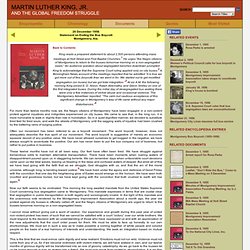

Knots. American Experience.Eyes on the Prize.The Story of the Movement. Just a few months after Emmett Till's murder, a 43-year-old civil rights activist, Rosa Parks, refuses to give up her seat on a segregated bus in Montgomery, Alabama, and is arrested.

Parks' arrest inspires black leaders to mount a one-day bus boycott. With the help of Jo Ann Robinson of the Women's Political Council, 40,000 people are organized in just two days. On the night of December 5, 1955, elated at the day's success in emptying the buses, boycotters assemble at the Holt Street Baptist Church and vote to keep the protest going. A main speaker is a new minister in town, 26-year-old Reverend Martin Luther King, Jr. Because he has no history with the town leaders, other ministers, including Ralph Abernathy and Fred Shuttlesworth, persuade King to lead the Montgomery Improvement Association and the boycott. The boycott lasts until December 1956. Context Other Events: 1956 Communist leader Nikita Khrushchev tells the West, "We will bury you! " Press The Washington Post, April 25, 1956 ... " Mlk-kpp01.stanford.edu/primarydocuments/Vol3/Dec-1956_WeAreStillWalking.pdf. Tell It To Old Grandma. Statement on Ending the Bus Boycott.
Back to Contents King reads a prepared statement to about 2,500 persons attending mass meetings at Holt Street and First Baptist Churches.1 He urges “the Negro citizens of Montgomery to return to the busses tomorrow morning on a non-segregated basis.”

An audience question about segregated benches downtown prompted King to acknowledge that the Supreme Court ruling applied only on city buses.2 A Birmingham News account of the meetings reported that he admitted “it is true we got more out of this (boycott) than we went in for. We started out to get modified segregation (on buses) but we got total integration.”3 At six A.M. the following morning King joined E. D. Nixon, Ralph Abernathy, and Glenn Smiley on one of the first integrated buses. For more than twelve months now, we, the Negro citizens of Montgomery have been engaged in a non-violent protest against injustices and indignities experienced on city buses. Often our movement has been referred to as a boycott movement. TD. Montgomery Bus Boycott (1955-1956) Sparked by the arrest of Rosa Parks on 1 December 1955, the Montgomery bus boycott was a 13-month mass protest that ended with the U.S.

Supreme Court ruling that segregation on public buses is unconstitutional. The Montgomery Improvement Association (MIA) coordinated the boycott, and its president, Martin Luther King, Jr., became a prominent civil rights leader as international attention focused on Montgomery. The bus boycott demonstrated the potential for nonviolent mass protest to successfully challenge racial segregation and served as an example for other southern campaigns that followed. In Stride Toward Freedom, King’s 1958 memoir of the boycott, he declared the real meaning of the Montgomery bus boycott to be the power of a growing self-respect to animate the struggle for civil rights.
The roots of the bus boycott began years before the arrest of Rosa Parks. King recalled in his memoir that ‘‘Mrs. On 5 December, 90 percent of Montgomery’s black citizens stayed off the buses. U.